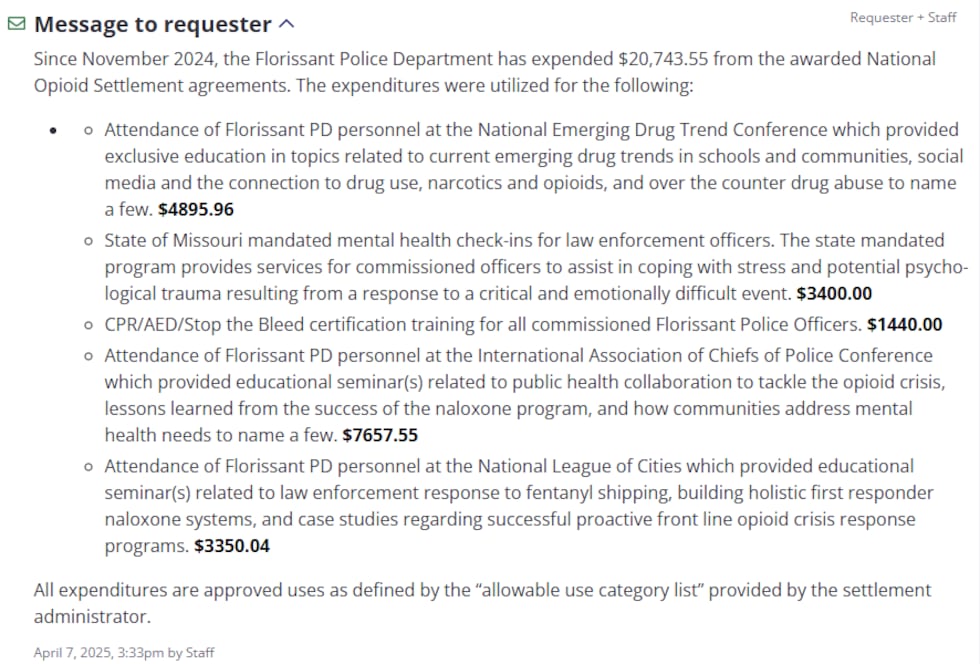How is your local government using opioid settlement funds? Check and see
First Alert 4′s searchable database lets you know how transparent counties and cities are with their uses of the money

ST. LOUIS (First Alert 4) -- Public records shed light on how transparent St. Louis-area governments were in describing their use of more than $1 million in opioid settlement funds through 2024, two years after the windfall of payments began.
First Alert 4 filed 30 public records requests with cities, counties, and agencies receiving settlement funding and asked them to provide expenditure reports for uses up to January 20, 2025. One pattern was not utilizing the money at all - 14 municipalities had not spent or allocated any of the funds, which are supposed to go toward remediating the opioid crisis fueled by the overprescribing and marketing of addictive drugs.
Of the local governments that have used funds, most of them provided short descriptions of the uses, the same information that shows up in the state’s portal every March. But the descriptions included in the reports often leave the specific purpose unclear or ambiguous.
For example, Kirkwood listed “Alternative Response Vehicle(one-half total cost)” as a description and filed it under the allowable use category of “First Responders.” First Alert 4 found through its own inquiry that the vehicle was a Ford F350 with a snowplow attached.
The database in this article is aimed at making it easier for the average person to know what their city or county is spending these dollars on and includes as much clarity as governments were willing to provide in response to records requests.
The searchable database below includes 30 local entities, from St. Louis and the surrounding urban areas to rural counties like Crawford and Lincoln. Scroll further down to see all documents provided to First Alert 4 in response to records requests.
Have a story about opioid settlement funds? Send me an email: [email protected]
The following documents were what counties and cities receiving opioid settlement funding provided to First Alert 4 in response to public records requests for expenditure reports detailing what the funds were used for. They are listed in alphabetical order. Click Ctrl+F(Command+F on Mac) to easily find your municipality.
Ballwin
The city of Ballwin provided the same documentation that is shown in the state of Missouri’s yearly report. It includes short descriptions of what the funds were used for and the allowable use category under the Opioid Settlement Agreement. Some of the expenditures were for police conferences, but the descriptions do not say how it contributed to opioid abatement.
Chesterfield
The city of Clayton provided the same documentation that is shown in the state of Missouri’s yearly report. It includes short descriptions of what the funds were used for and the allowable use category under the Opioid Settlement Agreement. All opioid funds spent by the city have gone toward treatment court.
Clayton
The city of Clayton provided the same documentation that is shown in the state of Missouri’s yearly report. It includes short descriptions of what the funds were used for and the allowable use category under the Opioid Settlement Agreement. Some of the 2024 expenditures were for an “Emerging Drugs Conference,” but the descriptions did not include who attended the conference.
Crawford County
Crawford County provided the organizations and agencies receiving funds and the amounts allocated but did not include the allowable use categories included in the state’s report. Its allocations include treatment providers, law enforcement, and organizations that assist people with substance use disorders.
Creve Coeur
The city of Creve Coeur provided short descriptions of uses and vendors for expenditures but did not include the allowable use categories that appear in the state’s yearly report. Records show $25,514 was for “opioid fund remittance to state” in 2022 and 2023.
Eureka
The city of Eureka provided an email response listing expenditures as Narcan kits for $647, Narcan spray for $922 and $60 in wire transfer fees. Eureka has received just more than $33,000 in opioid settlement funds. The city did not provide documents on the funds that have been spent through 2024.
Florissant
The city of Florissant provided descriptions of opioid settlement expenditures. Through 2024, all the allocations were made to the police department.

Franklin County
Franklin County provided detailed records showing the organizations funded through opioid settlements and what programs are being funded through those entities.
Kirkwood
The city of Kirkwood provided the same documentation that is shown in the state of Missouri’s yearly report. It includes short descriptions of what the funds were used for and the allowable use category under the Opioid Settlement Agreement. Several descriptions do not provide clear explanations for uses.
Lincoln County
Lincoln County provided short descriptions of uses and who the funding was paid to but did not include the allowable use categories that appear in the state’s yearly report. A November St. Louis Public Radio article cited the county’s plans to create a shelter with the funds.
O’Fallon(Mo.)
The city of O’Fallon provided the same documentation that is shown in the state of Missouri’s yearly report. It includes short descriptions of what the funds were used for and the allowable use category under the Opioid Settlement Agreement. It spent $10,213 on cases of gloves for harm reduction, and $9,400 on AED carrying cases.
St. Charles County
The city of O’Fallon provided the same documentation that is shown in the state of Missouri’s yearly report. It includes short descriptions of what the funds were used for and the allowable use category under the Opioid Settlement Agreement.
St. Louis City
The city of St. Louis provided nearly the same documentation that is available on the state’s website. It lists funding recipients, spending categories, and contract amounts and periods.
St. Peters
The city of St. Peters provided expenditure reports for naloxone.
Town and Country
The city of Town and Country provided a report showing funds used for “Police Security and Safety Expenses” and “Police Training Expenses.”
Washington County
Washington County provided documents showing funding requests, project overviews, statements of need, budget details, and item descriptions. The county’s response to records requests for the use of opioid settlement funds was by far the most detailed and transparent.
Wentzville
The city of Wentzville provided the same documentation that is shown in the state of Missouri’s yearly report. It includes short descriptions of what the funds were used for and the allowable use category under the Opioid Settlement Agreement. Most of the funds went to the START program for classroom supplies, books, and T-shirts.
Copyright 2025 KMOV. All rights reserved.














